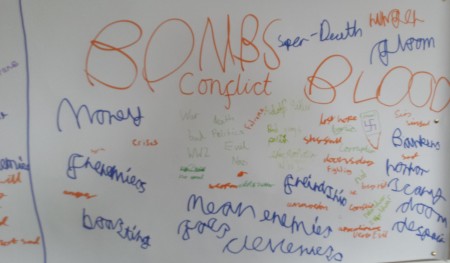About this Collection
What do I want to find out?
The extent to which pupils’ understanding of peace and conflict is developing. The activity can capture the depth and breadth of their knowledge and understanding, alongside their changing attitudes towards conflict and peace. It can be embedded within your teaching, for example about Remembrance Day, the centenary of the First World War or other anniversaries of major conflicts.
What do I need?
- Two sheets of flipchart paper, pens in five different colours, at least two of each colour.
- A piece of paper for each pupil.
What do I do?
Timing: 10 minutes, then ongoing
 Ask pupils working individually to divide their paper in half and write down everything they associate with ‘peace’ on one side and ‘conflict’ on the other. Collect this work and keep it safe.
Ask pupils working individually to divide their paper in half and write down everything they associate with ‘peace’ on one side and ‘conflict’ on the other. Collect this work and keep it safe.- Write the word ‘peace’ on one piece of flipchart paper and ‘conflict’ on the other. Stick them to a wall, where pupils can easily reach them without disrupting each other. Attach a pen to each, the pens should both be the same colour.
- Explain to pupils that the pieces of flipchart paper are there for them to add words or phrases to, whenever they like, during the course of the scheme of work. They are free to walk up to the paper and write on it, but only using the pens attached.
- Throughout the topic, at regular intervals, change the pens to a different colour so you can track changing/developing ideas. Keep a record of when you change the colour of the pens, recording at what point during the topic you do this. Don’t use the same colour twice.
- Photograph the final sheets.
How do I analyse the results?
- Look through the individual sheets the pupils worked on at the start, note the words they associate with peace and conflict and how often the same words/phrases appear.
- As the lessons progress, and the different coloured pens are introduced one at a time, you should be able to see the progression of your pupils’ thinking, so you can track their understanding of the concepts developing over time.
- To what extent are initial responses about conflict focussed on the glorification of weapons or war, stereotypes about places of conflict or about terrorism?
- To what extent are initial responses about peace quite simplistic? Look for them focussing only on an absence of conflict, rather than an awareness of the relationship between peace and justice and of the need to work for peace.
How do I measure the change?
- Using the completed flipcharts/photos of them, look for a shift towards a more nuanced and balanced understanding of conflict and its consequences, and an appreciation of co-operation, negotiation, respect and justice, peace movements locally and globally. Compare with your analysis of the individual data collected at the start
- To what extent do pupils show increasing empathy towards those suffering in areas of conflict?
- Look out for pupils develop an understanding of how peace is negotiated following times of war, and of the role of international organisations in brokering peace deals, promoting reconciliation and of international courts
- How do pupils demonstrate an awareness of the connection between global conflicts and local, classroom or community level conflicts and express an increased willingness or interest in ways in which they might take action for peace?

